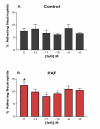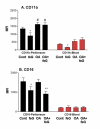Modulation of neutrophil function by the tripeptide feG
- PMID: 12659660
- PMCID: PMC152650
- DOI: 10.1186/1471-2172-4-3
Modulation of neutrophil function by the tripeptide feG
Abstract
Background: Neutrophils are critical in the defense against potentially harmful microorganisms, but their excessive and inappropriate activation can contribute significantly to tissue damage and a worsening pathology. Through the release of endocrine factors submandibular glands contribute to achieving a balance in neutrophil function by modulating the state of activation and migratory potential of circulating neutrophils. A putative hormonal candidate for these effects on neutrophils was identified as a heptapeptide named submandibular gland peptide T (SGP-T; sequence = TDIFEGG). Since the tripeptide FEG, derived from SGP-T, and its D-amino acid analogue feG had similar inhibitory effects on inflammatory reactions, we investigated the effects of feG on human and rat neutrophil function.
Results: With human neutrophils feG had no discernible effect on oxidative burst or phagocytosis, but in picomolar amounts it reduced PAF-induced neutrophil movement and adhesion, and the binding of CD11b by 34% and that of CD16b close to control values. In the rat feG (10-11M) reduced the binding of CD11b and CD16 antibodies to PAF-stimulated circulating neutrophils by 35% and 43%, respectively, and at 100 micrograms/kilograms intraperitoneally feG reduced neutrophil in vivo migration by 40%. With ovalbumin-sensitized rats that were challenged with antigen, feG inhibited binding of antibodies against CD16b but not CD11b, on peritoneal leukocytes.
Conclusions: The inhibitory effect of feG on neutrophil movement may be mediated by alterations in the co-stimulatory molecules CD11b and CD16.
Figures










References
-
- Rougeot C, Vienet R, Cardona A, Le Doledec L, Grognet JM, Rougeon F. Targets for SMR1-pentapeptide suggest a link between the circulating peptide and mineral transport. Am J Physiol. 1997;273:R1309–R1320. - PubMed
-
- Mathison RD, Befus AD, Davison JS. A submandibular gland peptide protects against endotoxin induced hypotension. Am J Physiol. 1997;273:R1017–R1023. - PubMed
Publication types
MeSH terms
Substances
LinkOut - more resources
Full Text Sources
Other Literature Sources
Research Materials

